Vermeer Audio TWO
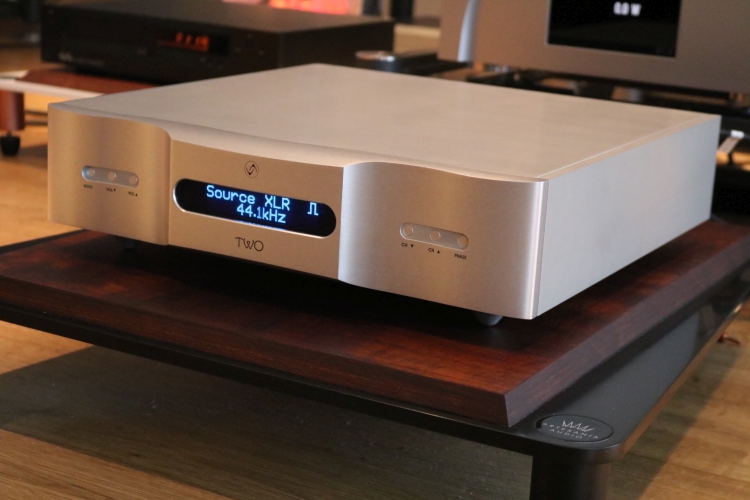
Listening – Analog Inputs
Up until now, the TWO has been listened to with its digital inputs followed by its internal DAC and tube output section. But its analog section can also be used stand-alone, as a pure analog preamp.
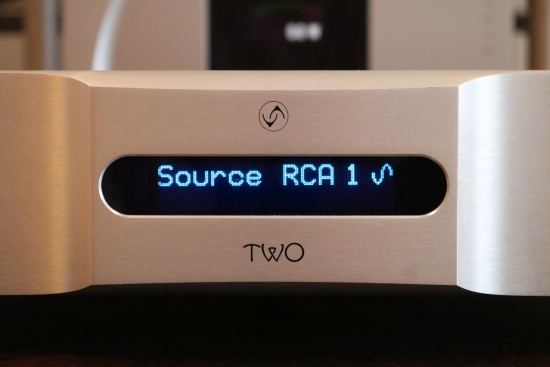
Any preamp with a built-in DAC has two instances where the sound is shaped: the preamp and the DAC itself. When listening to the TWO with a digital input, you hear the result of both. In an ideal world, both would be infinitely transparent and totally devoid of character, but in reality, I have never heard this to be the case. In order to find out how the TWO’s preamp sounds on its own, I conducted a small experiment using the Aqua LinQ streamer as a central digital source to provide a digital output as well as an analog output to feed both to the TWO. To this end, the LinQ’s AES/EBU output is connected directly to the TWO via the Jorma AES/EBU cable while the LinQ’s I2S output is connected to the Formula xHD DAC that is in turn connected to the TWO via its cinch and XLR outputs using Vermouth Reference cables. This way, I was able to switch between the two inputs on the fly.
I will admit that this is not an entirely valid comparison, of course, as the Aqua DAC and the analog cable will inevitably influence the sound differently than a direct digital connection to the Vermeer’s built-in DAC, but because I know the Aqua DAC very well, it will still give me a good handle. Also, this is also just the first step in the assessment of the TWO’s analog inputs so please bear with me.
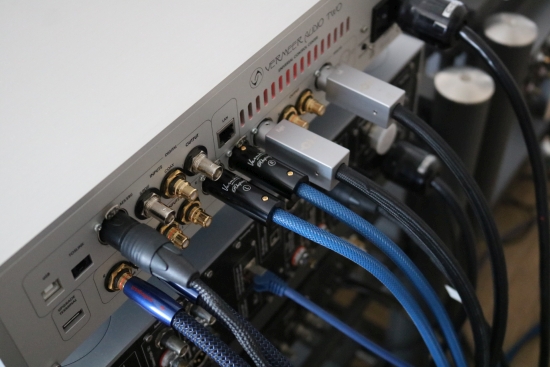
Interestingly, compared to the AES input, the TWO’s analog input (whether via cinch or XLR) sounds more potent and upfront, trading some of the lushness and organic qualities for a more incisive boldness. Especially in the midrange, the sound is more forward and less sweet, and the soundstaging is also different, more focused and upfront and projected less behind the speakers. These differences are quite profound but once accustomed to the new presentation, I could get into it again. It’s impressively dynamic and energetic, open and communicative and when then returning to the AES input, I had to get used to the comparatively milder and more relaxed presentation again.
The next question on my mind was whether the TWO’s preamp sounded bolder and more forward when accessed on its own or that the built-in DAC was responsible for the natural and organic presentation. The answer, no doubt, lies in the middle. While the Aqua DAC has a different character than the TWO, I have heard it with enough other preamps to be intimately familiar with it. Further tests using the CH Precision P1 phono preamp’s output and a comparison to two other analog preamps (see below) confirm that the TWO’s preamp section does indeed sound remarkably punchy and dynamic when accessed via its analog inputs.
What this would logically mean is that the TWO’s built-in DAC, or the implementation thereof, is largely responsible for the TWO’s relaxed and organic sound as described earlier. This, in turn, leads to the somewhat unexpected result of the TWO sounding the sweetest and most stereotypically tube-like when using its own built-in DAC, even though its tube section is always in use.
While one would normally assume that all inputs should sound the same (and with some all-in-one components they do indeed), the difference in character between analog and digital inputs is not all that uncommon, though. The same is true for the Ayon Stealth and in much the same was as it happens with the TWO: bolder with analog inputs and smoother with digital inputs. Most importantly, the TWO sounds superb in either mode.
As I mentioned at the start of this section, using an external DAC is only the first step. Now, let’s go all the way and connect the Origin Live Calypso mk4 turntable with the CH Precision P1 phono stage.
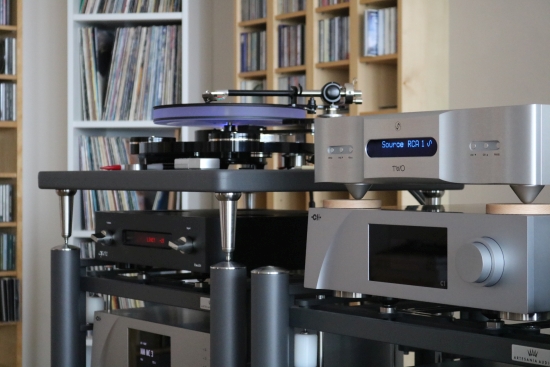
Listening – Vinyl
Because the TWO contains a full-fledged analog preamp, analog inputs remain 100% analog throughout the entire signal path. While it was useful feeding its inputs with the output from another DAC to form first impressions of the quality and character of the preamp, when thinking of analog, the ultimate source for me is Vinyl. Granted, Reel-to-Reel can sound even better but this format can’t compete with the massive worldwide library that is available for LP’s.
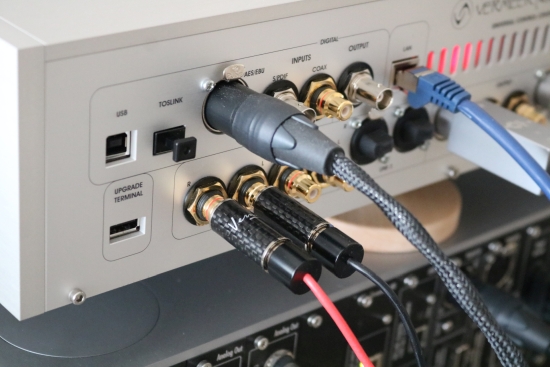
Jorma AES/EBU and Vermouth Reference Phono Cable connected to the TWO’s inputs.
For this Vinyl session, the Origin Live Calypso mk4 turntable with ViRa Aidas Rainbow MC cartridge connects to the CH Precision P1 phono preamp which in turn connects via Vermouth Reference phono interlinks to the preamp. The latter is normally the Ayon Stealth (also a tube preamp), a role that is now being taken over by the Vermeer TWO. The power amp remains the CH A1.5, connected with a CH Precision Balanced Link.
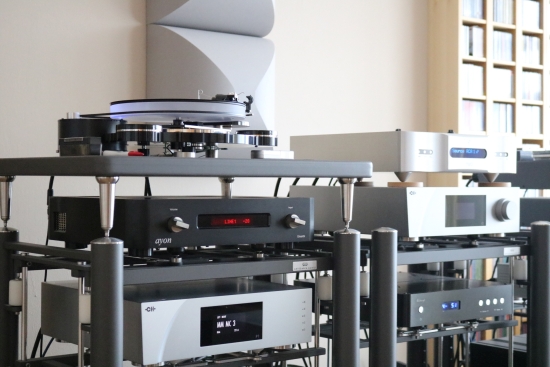
All it took were a couple of bars from the Jones Girls’ Nights of Egypt intro to hear that the TWO offers a resolution, transparency and linearity that go well beyond what the Stealth can do. I always knew that the Stealth is not super highly resolving but its solid bass, tonal fullness and big dynamics go a long way to make up for this. Especially for analog replay, I find that it’s not a bad thing for a preamp to be a little less revealing as long as the musical spirit comes through. And the latter is never in question via the Ayon. I have also tried several transistor preamps in all price ranges for this purpose, but for LP playback, I always preferred the Ayon in spite of its audiophile shortcomings. But now, here’s the Vermeer TWO, ticking all the audiophile boxes: resolution, transparency, airiness, linearity, tightness, speed, and articulation and extension in both directions. Every record that I play, further confirms this. As much as I like the Ayon, the Vermeer simply performs in a higher audiophile league. But what about the emotional aspect, I hear you ask? Not to worry, as the Vermeer simply has this down, too! Call it musical, emotionally appealing, non-synthetic or non-technical, the TWO has it in spades. The TWO’s transparent and linear delivery does mean that you hear better what’s on the record and that’s only fair. Thin-sounding records are beautifully enhanced by the Ayon but, ultimately, that’s a pleasant EQ and a deviation from neutrality.
But even with so-so records, the TWO offers the ease and flow that tubes typically do so very well. And, importantly, even though it craftily avoids sounding cold or technical, there is none of the thickness, smoothing, or coloration that lesser tube designs often bring. Very well done Vermeer!
Upcoming other Vermeer Products
Very soon, the model THREE will be introduced, containing exactly the same DAC section, built into a less massive chassis and with the LAN board as an option. The THREE will cost 15.590 Euro for the DAC+Network player model (with the LAN board included) and 11.990 Euro for the DAC-only model.
The main difference from the TWO is that the THREE does not contain the analog preamp section and thus also not its analog volume control but rather a very special digital volume control based on Leedh processing from Acoustical Beauty. This technology can also be found in some Soulution converters and recent Lumin devices.
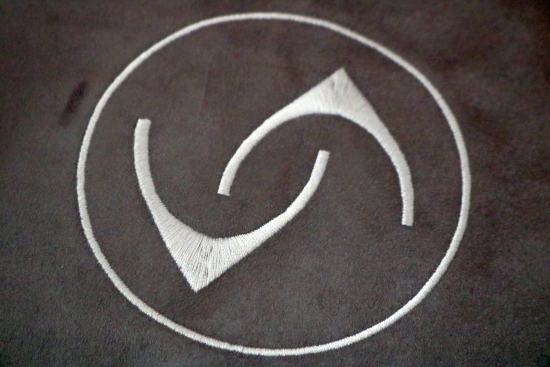
Conclusion
Let’s get the main thing out of the way: the price. 24.999 Euro is not pocket change. But considering that it offers similar functionality as the CH C1 that commands around 40.000 Euro including the required input boards, it’s starting to look a lot better. Then, consider how much a superb analog preamp will cost and the requested sum for this 3-in-1 Universal Control Center starts to make sense. The TWO can be at the heart of multi-source analog/digital systems and it can function as the integrated front end of a minimalistic system with the addition of only a server and active speakers. For those who would like to obtain the Vermeer DAC quality but have no need for an analog preamp, the THREE is a more cost-effective solution.
It is Vermeer Audio’s goal to make products that sound as realistic as possible and, by extension, to have low distortion and not to add any coloration and I can confirm that those boxes are comfortably ticked. It’s linear, highly resolving, articulate, transparent, and clean without sounding clinical and very slightly rich but without really sounding warm. Perhaps a better word would be natural. Whilst being open and direct, the TWO also has an organic naturalness and charm with an unhurried presentation along with superb fleshing out of the natural harmonics that makes it very easy to listen to.

Videos on the Hifi-Advice YouTube Channel
How Sooloos became Roon
HFA Front Page
Try out Roon for yourself
External Links
Manufacturer: Vermeer Audio
Distributor for the Netherlands: Aequo Audio
PRESTIGE AUDIO DIFFUSION
Distributor for France / Monaco / Belgium / Luxembourg / French part of Switzerland
Contact : Marc Loubeau
Tel : +33(0)6 49 89 68 88
Email : contact@prestigeaudio-diffusion.fr
Website: www.prestigeaudio-diffusion.fr

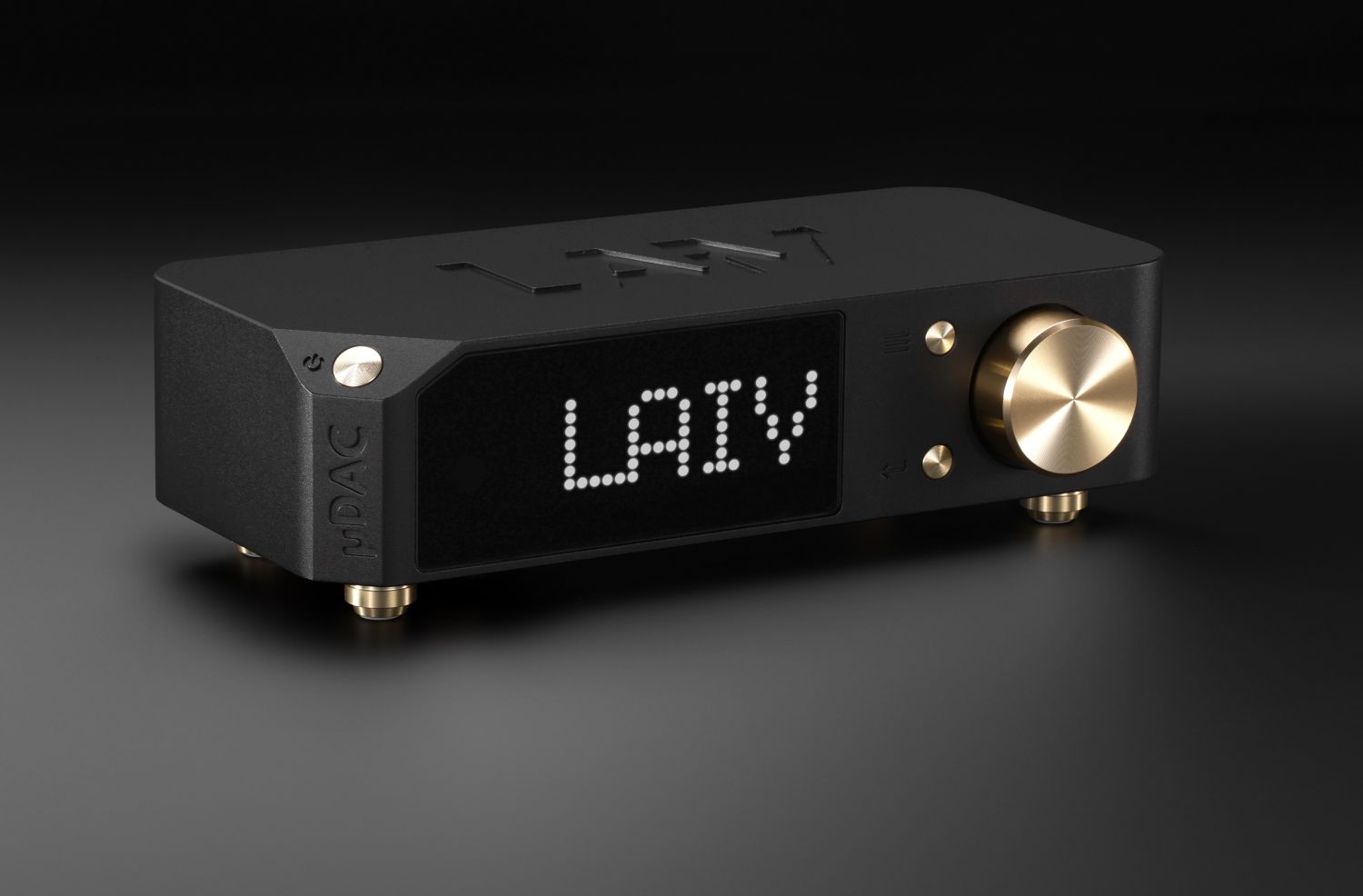
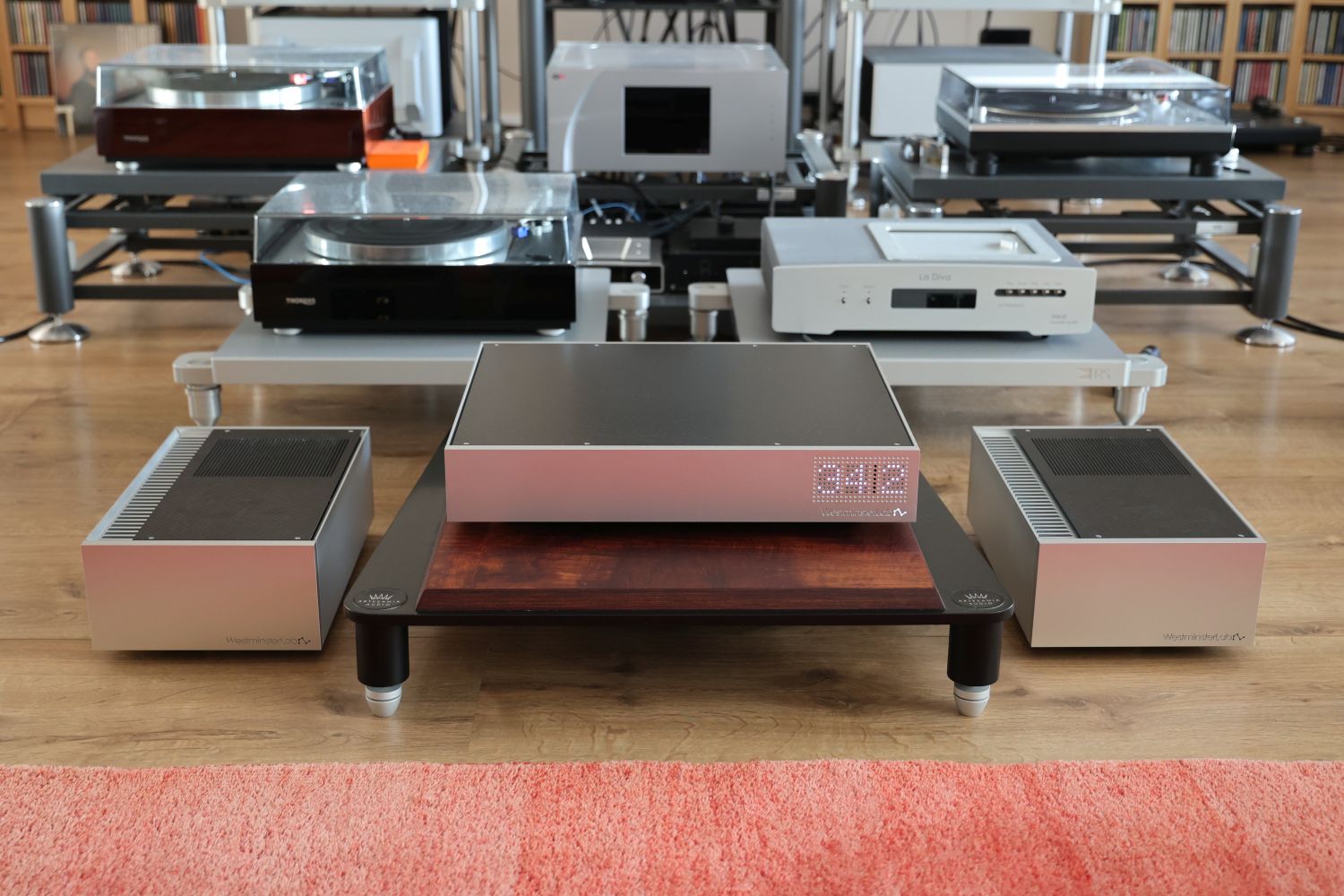
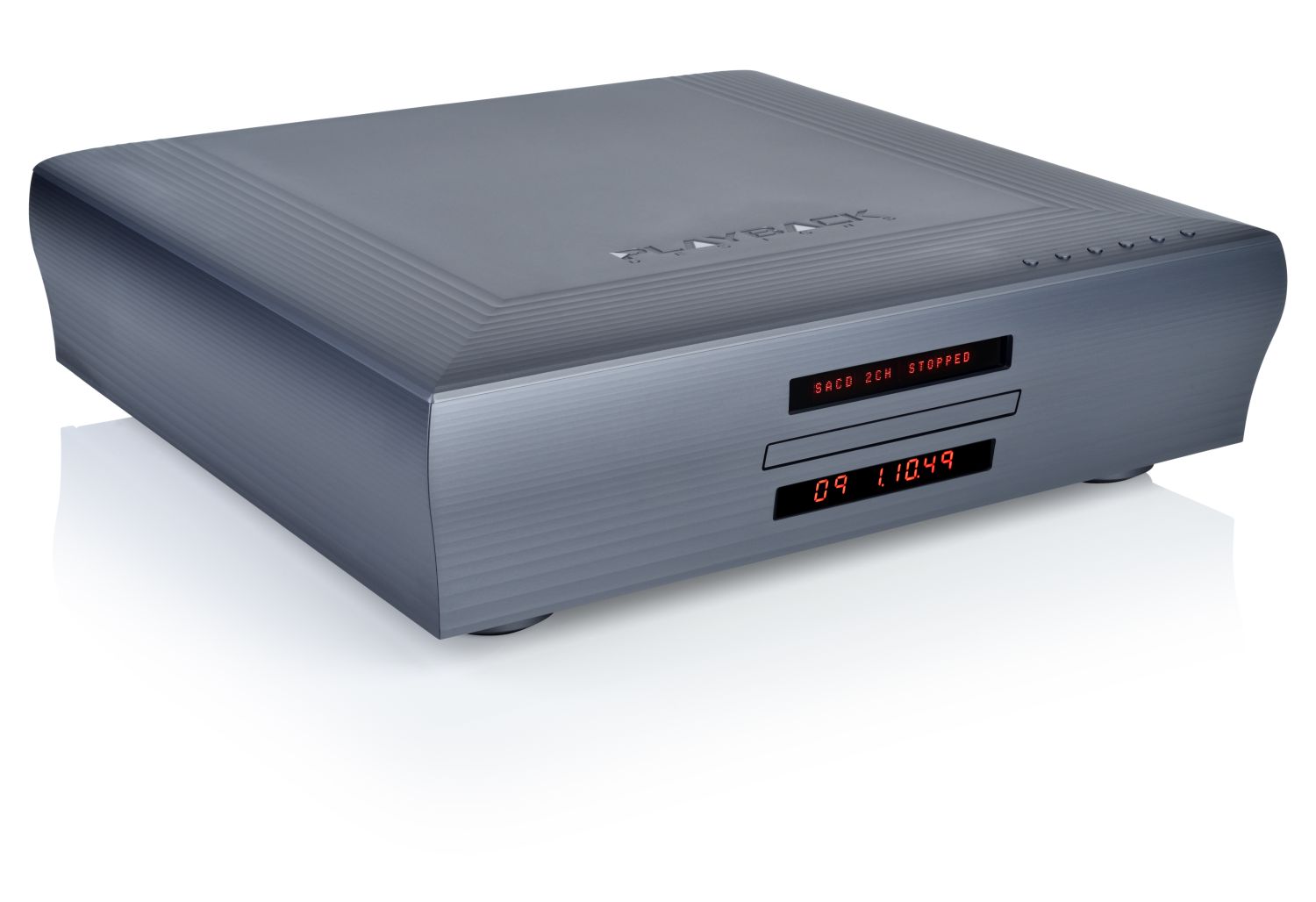

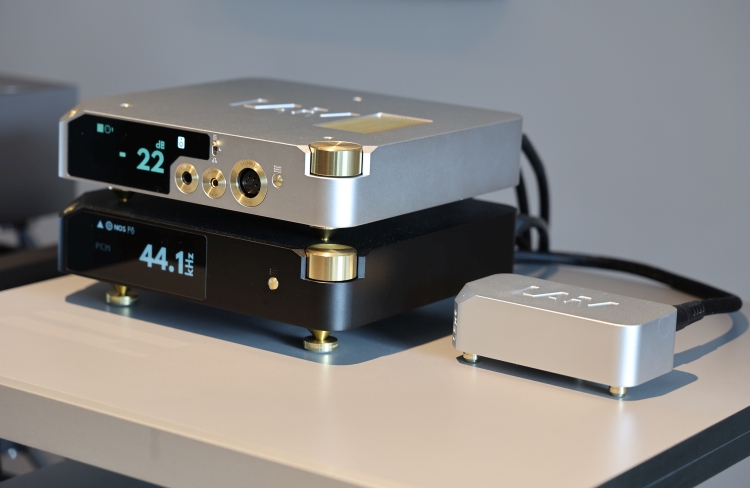


Very, very detailed and interesting review!
One of the very few that are focused on the very important issue of digital inputs.
(USB, Ethernet and analog)
I am exactly convinced (as I understand from your excellent writing) that the digital architecture of an “all in one” device, when built and studied at the highest level, leads to results above (almost) everything and not only because the “old dogma” (less is more) remains a dogma. Cables, connectors and above all the generation of “Clock” (and jitter) could mean something when in fact, they can (almost) not be around anymore.
Recently I asked some questions to TOP manufacturers like “MSB” and “Bricasti Design” and “Simaudio-Moon” about it but for now the answer has been “generic” (even when buying a MSB DAC you have the possibility to buy “optional modules”: streamer or USB plus? ) and is summed up with … “Ethernet is better”.
Thanks, Luca.
Hi Luca,
The trouble is that the success of any interface input is reliant on the quality of the interface output on the other end, and vice versa. I think this is where much of the controversy on the subject stems from, and also, why many manufacturers just decide to offer all of them in an effort to bet on all horses. Ethernet has some inherent advantages for which one could consider it the best protocol but there is still variance. In spite of the specs as well as popular thinking, it seems that this kind of connection is also not immune to noise and other parasitic influences. Otherwise, why do audiophile switches and ethernet cables have an audible effect?
USB and AES/EBU or S/PDIF have their own inherent benefits as well as potential issues, and so, depending on the circumstances, people can prefer Ethernet or any other format. I always advise to try your options and simply stick with what works best!
Christiaan, I totally agree with you;
we must always try in our system the “effect” of inserting a new device including obviously “how it is connected”.
Investigating more in depth, however – with the same “quality of design and so on” – could one “way” rather than “another way” be better anyway?
I mean: from your excellent test, in the system you used, you had clear “preferences” and, all the designers I spoke to -by email- tell me that Ethernet is “preferable” anyway, as you wrote more or less and, it does not seem a coincidence.
Where do I want to go?
Perhaps that “less is more” where a Steamer / DAC architecture in a single frame …
Greetings and great listening!
Hi Luca, for me, both Ethernet and AES/EBU lead to the most consistent results. I do ultimately prefer AES/EBU but in this case, Ethernet worked beautifully, partially indeed thanks to the well-integrated streamer component. Less is more is not sacred but in terms of cost/performance, you can’t beat an all-in-one, especially when the streamer and DAC are well-interfaced and well-implemented.
It’ok. Almost obvious.
I was referring to the USB connection anyway.
(However more “difficult” to “treat”)
Bye.
Indeed, you asked about USB versus Streaming in relation to the MSB DAC and asked me what my preference is. From my personal experiences, I prefer AES/EBU and Ethernet over USB. Most of the time, USB leads to a presentation that I feel sounds more mechanical and less involving than the other two. A more thorough description can be read in the Antipodes K50 and Aqua LinQ reviews.
Yeah. 😉
Did I read understand that right that the tubes are soldered directly to the board??? This isnt a cheap preamp and for a basic tube change I would have to take it to a qualified tech or at least someone that can solder. You should try an Innuos Phoenix USB interface, it seriously will make you rethink USB…I use a Phoenix with excellent results. Great reviews by the way.
They are soldered indeed… but they have an incredibly long lifetime. And they are not like normal tubes, these ones are miniature and they have long, flexible legs, like those on LEDs or through-hole Capacitors. So if they need to be replaced, it’s not difficult, provided they are still in stock. Innuos Phoenix USB interface, noted!